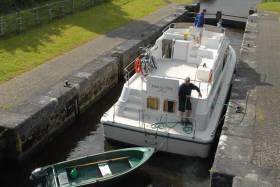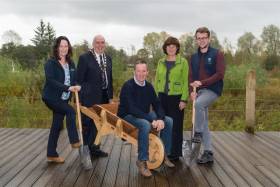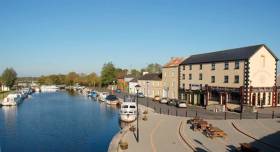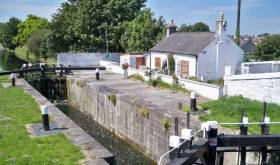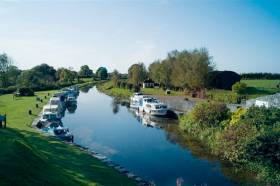Displaying items by tag: Royal Canal
Boost To Waterways Ireland Capital Funding In 2019: Minister
#InlandWaters - Funding for Waterways Ireland is on the rise, and particularly for projects in the Dublin region, according to Heritage Minister Josepha Madigan.
Responding last week to a Dáil question from Cavan-Monaghan TD Brendan Smith, Minister Madigan outlined that estimates for 2019 provide for an allocation of €25,117,000 for Waterways Ireland, representing an overall increase of €1 million on last year’s original allocation.
Within this figure, capital funding for Waterways Ireland has been increased by €800,000 from €3,580,00 to €4,380,000 in 2019.
In response to Dublin West TD Joan Burton, through whose constituency the Royal Canal flows, Minister Madigan provided a breakdown of Waterways Ireland’s Exchequer (current and capital) funding allocation from 2016 to present.
The level of funding provided for maintenance and upgrade of waterways, canals and rivers in Co Dublin specifically as been forecast at €3,153,665 for 2019 — compared to €1,158,136 in 2018.
Responding to a follow-up question from Deputy Smith regarding specific capital funding for maintenance and improvement works on the Shannon-Erne Waterway, Minister Madigan outlined that Waterways Ireland plans to complete 10.4km of Greenway enhancement towpath as well as advance plans for a full-scale Greenway along the 64km route.
Capital funding allocated for Shannon-Erne works is €125,000 for 2019, and Waterways Ireland is partnered with local authorities for three projects to the tuned of €311,500:
- Development of a Blueway trail between Leitrim Village and Kilclare with Leitrim County Council (€162,000 WI contribution).
- Development of a Blueway trail between Ballyconnell and Bellaheady Bridge with Cavan County Council (€124,500).
- Development of forward planning for a trail extension from Aghalane to Lock 1 at Corraquill with Cavan County Council (€25,000).
The minister underlined that any requests for additional funding from Waterways Ireland in 2019 “can only be considered on their merits, taking into account the organisation’s strategic business objectives for the waterways network and the estimates and annual budgetary processes.”
Previously, Kildare South TD Fiona O’Loughlin asked the minister the extent to which she expects an amicable resolution to issues between Waterways Ireland and traditional dwellers and recreational users of the Grand Canal in Co Kildare.
Minister Madigan replied that Waterways Ireland “continues to concentrate on boats which consistently remain in breach of the bye-laws”, and that the cross-border body “will consult with its stakeholders in the drafting of additional bye-laws to ensure proper regulation of craft on the waterways” following the signing into law last summer of the Heritage Act 2018.
Handcrafted Tools Bring Royal Canal’s History to Life
#InlandWaters - Tools created by local Fermanagh craftsperson Albert Robinson were a key feature during this year’s World Canals Conference.
The tools, displayed in archive exhibition ‘Reflections, the Lasting Legacy of the Waterways’, brought to life the story of the strong men who powered the construction of Ireland’s canals system over 200 years ago.
Commissioned by the Directors General of Inland Navigation in 1813, the final section of the Royal Canal in Ireland to connect with the Shannon River was an extraordinary feat of ingenuity, engineering and sheer hard labour.
The contract to build the canal — complete with 21 locks, an aqueduct, 38 bridges, 40 tunnels, and numerous quays and harbours — was undertaken by Henry, Mullins and MacMahon in 1814 under the direction of the pre-eminent Irish engineer of that time, John Killaly.
Remarkably, that final section was completed within three short years at a cost of £198,110, covering a distance of some 24 1/2 miles.
What is most striking is that the tools available to the canal builders at this time, the world-famous ‘navvies’, were so basic.
Under the building contract, a detailed design specification was prepared for the manufacture of these tools to the company standard.
Local man Albert Robinson, a carpenter with Fermanagh and Omagh District Council, meticulously recreated these tools – a hand barrow and a wheelbarrow – using the specific wood types, elm for strength and ash for flexibility.
Patterson’s Spade Mills, owned and run by the National Trust, is the last remaining spade mill in daily use in Britain and Ireland. They, too, faithfully recreated objects from the original drawings, producing a spade and shovel.
The tools were on display throughout the World Canals Conference — which attracted over 320 delegates from 12 countries across three continents over its three days last month — and provoked much positive comment and requests for further displays of this quality work.
Commenting on the unique collection of handcrafted tools, Dawn Livingstone, chief executive of Waterways Ireland, said: “Working in partnership with Fermanagh & Omagh District Council and the National Trust, we have brought back to life a remarkable era of canal construction and created objects that tell the story of the men who built the amazing waterways that we continue to enjoy today.
“I commend the skill of the craftspeople involved from Fermanagh & Omagh District Council and Patterson's Spade Mill and would encourage visitors to see this extraordinary collection for themselves.”
Speaking about the exhibition, chairman of Fermanagh and Omagh District Council, Councillor Howard Thornton, said: “I am tremendously impressed by the craftsmanship shown by Albert in the recreation of the tools used in the construction of the final section of the Royal Canal.
“Albert’s ingenuity and craftsmanship have often been utilised in his work with Fermanagh and Omagh District Council and I am delighted that his talent has been showcased to a wider audience at such a prestigious event.”
Nathan Domer, visitor experience officer with the National Trust, added that “this type of project is at the forefront of our core aims as a charitable organisation to conserve our heritage on land and on water for all to enjoy for ever, for everyone."
The tools and the original blueprint drawings in the exhibition can be viewed at Waterways Ireland HQ at 2 Sligo Road, Enniskillen weekdays from 9.30am to 5.15pm till Friday 9 November.
#InlandWaters - Tourism and activity providers along with local communities along the route are invited to attend a series of workshops aimed at developing the Royal Canal as an attraction for domestic tourism and visitors from abroad.
Coming ahead of next year’s launch of the Royal Canal Greenway, the capacity-building workshops will help project partners engage with local trades, businesses and others to showcase the proposed plans in developing the Royal Canal as a destination.
The long-awaited Blueway and Greenway trails on and along the 144km of canal and towpath from Dublin to Longford will be the focus of the workshops, the first of which will be held next week in Mullingar on Thursday 24 May from 6.30pm at the Mullingar Park Hotel.
Dates and venues for subsequent workshops in Longford town, Maynooth and Dublin are to be confirmed. All are hosted by Waterways Ireland with the respective local authorities.
Once complete, the Royal Canal Greenway will be the longest off-road walking and cycling trail on the island of Ireland.
Accompanying this will be a series of Blueway developments, the first being located in Mullingar where a 22km paddling trail and activity hub will be established.
The workshops will encourage the development of activity based packages, dining and accommodation packages and promotional materials which will activate the region and place the product in the ‘shop window’ for both the domestic and international tourist.
The Royal Canal is also at the heart of Ireland’s Ancient East and Ireland’s Hidden Heartlands, two tourism initiatives developed by Fáilte Ireland.
#InlandWaters - Waterways Ireland advises masters and owners of vessels on the Royal Canal at the Clondra, Co Longford end that:
- Non-permitted vessels, as per Article 6(8) of the Canal Act 1986 (Bye-Laws) 1988
- Non-attended and apparently abandoned vessels (Article 6(8))
- Doubled moored and causing obstruction (ie sunk) (Article 27 (3))
- Vessels deemed to be/likely to cause a hazard to navigation (Article 33(3))
may be removed from the Coolnahay and Richmond Harbour areas, east of the 45th Lock, within two weeks of this notice, posted Tuesday 3 April 2018.
Removed vessels may then be subsequently disposed of in accordance with Article 34(2).
Classes of vessels mentioned above will be stickered, given suitable access, and then removed from the waterway as operationally convenient in order to clear berths for visiting boats and the navigation for cruising vessels.
New Lease Of Life For Royal Canal Lock House
#RoyalCanal - In news you may have missed from this year, the first lock house on the Royal Canal in Dublin is set for a new lease of life.
A familiar sight for locals and commuters in the city’s North Strand district, the cottage by Newcomen Bridge has been out of use for a number of years since its last residents, the Lynch family, moved on after four decades.
Now Waterways Ireland says it’s to be taken over by The Adventure Project, a city-based non-profit that runs adventure therapy programmes for addiction services, crime diversion projects and young people in care.
It’s expected that the cottage will become a base for a new canal adventure programme, making use of an already lively inland waterway amenity.
Waterways Ireland Archive Exhibition in Mullingar Celebrates 200 Years of the Royal Canal
#RoyalCanal - A forthcoming exhibition in Mullingar Library will celebrate 200 years of the Royal Canal through images and drawings from the Waterways Ireland archive.
Featuring a selection of images from the archive and from the Ruth Delany and Ian Bath Collections, the exhibition reveals the fascinating history of the Royal Canal over the past 200 years.
The photographs on display are a snapshot of the long history of the inland waterway but they are also testament to the work and efforts of individuals like Ruth Delany and Ian Bath to personally document its deterioration from the 1970s onwards and to highlight an awareness of the canal during the years of lobbying for support for its restoration.
The exhibition will be on display in Mullingar Library from next Monday 27 November to Friday 8 December during library opening hours:
Monday 10am to 5:30pm
Tuesday 10am to 8pm
Wednesday 11am to 5.30pm
Thursday 10am to 8pm
Friday 10am to 5pm
Saturday 10am to 1.30pm
No Further Passage In 2017 On Grand & Royal Canals
#InlandWaters - Waterways Ireland wishes confirms that no further boat movements will be organised into or out from Dublin east of Lock 12 on the Grand and Royal Canals until the 2018 season.
The Grand Canal will shortly be closed for works in the Bluebell area in Dublin, and water levels will be reduced for the winter season.
Waterways Ireland apologies for any inconvenience this may cause its customers and thanks their customers for their understanding in this matter.
The President of Ireland, Michael D. Higgins, commemorated the Royal Canal's 200th Anniversary in the presence of Waterways Ireland, the Royal Canal Amenity Group and invited guests in Clondra, Co Longford on the 27th May 2017. The President unveiled a plaque before speaking at the event in the presence of 300 guests.
The event took place on the anniversary of the day when the canal was completed all the way to the Shannon in 1817. During its heyday, people, coal and crops were moved to Dublin from Arigna Mines, farms and rural communities all over the North West, and people and goods returned. The Royal Canal closed in 1960 and remained closed for 50 years. The Canal reopened to navigation in 2010 following extensive lobbying and volunteer work by the Royal Canal Amenity Group and the work of Waterways Ireland staff. In its 25th year of operation the Royal Canal also saw the mass exodus of people escaping the famine by walking the towpath to Dublin to take a boat to the new world. The largest known group of 1490 people left the Mahon Estate at Strokestown House to walk to Dublin, along the Royal Canal, 175 years ago this week. They were also commemorated as part of the ceremony with President Higgins review of the bronze shoes and plaque on the plinth in Richmond Harbour. The shoes are similar to those given to the 1490 people for their journey to Canada.
As Minister for Arts, Heritage, Gaeltacht and the Islands, in the 1990's President Higgins had responsibility for the inland waterways in the portfolio. The President drove the re-vitalisation of the canal networks, including the redevelopment of the Royal Canal, through his efforts and funding for works on the canal.
Speaking about the role of the volunteers in the restoration, Matt Kennedy Chairperson of the Royal Canal Amenity Group said "this 145km Linear-parkway owes its existence to the perseverance and hard work by volunteers from the Royal Canal Amenity Group and staff from what is now Waterways Ireland. And as the Royal Canal moves into its next 100 years we look forward to working with Waterways Ireland and indeed all those who are committed to further developing and promoting this wonderful amenity as it moves to link up with walking and cycling routes across Europe"
Dawn Livingstone, Chief Executive, Waterways Ireland spoke saying "President Higgins spoke so eloquently about the Royal Canal and its place in our heritage. The Royal Canal is a wonderful recreational amenity free for all to use. Our partnerships with the local authorities, the boating groups including the Royal Canal Amenity Group, Fáilte Ireland and organisations such as the Irish Heritage Trust, are working to deliver new and exciting visitor experiences along the Royal Canal as such as the Blueway and the National Famine Way. These developments will deliver step change for tourism and the local economy in these areas."
James Osborne, Chairman of the Irish Heritage Trust said: "As the famine walkers set off today, they will not only be walking in the footsteps of the 1,490 Strokestown emigrants, but also helping to blaze a trail for the National Famine Way. It is only fitting that we mark this occasion with the unveiling of a nineteenth-century pair of shoes cast in bronze that is inscribed: “in Memory of the largest known group to have walked the full length of the Royal Canal – the 1,490 Strokestown Famine Emigrants in May of 1847”.
The President of Ireland, Michael D. Higgins, will commemorate the Royal Canal's 200th Anniversary in the presence of Waterways Ireland, the Royal Canal Amenity Group and invited guests in Clondra, Co Longford on the 27th May 2017. The event takes place on the anniversary of the day when the canal was completed all the way to the Shannon in 1817.
The Royal Canal closed in 1950 and remained closed for 50 years. The extensive lobbying and volunteer work of the Royal Canal Amenity Group and the work of Waterways Ireland staff and their predecessors in OPW was rewarded in 2010 when the Canal was reopened to navigation.
President Higgins has been a significant supporter of the Royal Canal and the inland waterways for many years. As Minister for Arts, Heritage, Gaeltacht and the Islands, the President drove the re-vitalisation of the canal networks, including the redevelopment of the Royal Canal.
Now a vibrant recreational location, investment by Waterways Ireland and Longford County Council in conjunction with Fáilte Ireland has revitalised Richmond Harbour, Clondra, now a Blueway hub. Additional investment by local authority partners along the length of the Royal Canal has seen the upgrade of the towpath to international trails standard. Only a short section in Co Longford remains to be upgraded before the entire 144km towpath can be promoted internationally.
Dawn Livingstone Waterways Ireland Chief Executive spoke saying "I am delighted that the Royal Canal Commemorations will be honoured by the presence of President Higgins. The volunteers and staff worked so hard to reopen this navigation. They have provided a valuable service to the people of Ireland by their fight to keep this wonderful recreational amenity in public hands. As a result it is here providing opportunities for every community to freely use for work, visit, play and thrive"
Should people wish to attend the commemorations on the 27th May, they are welcome to come to the harbour. The village will be closed to traffic from early on the day and so invited guests should park in Tarmonbarry where a small coach will bring them to and from the harbour.
Attendees can expect to see the unveiling of commemorative plaques, traditional crafts and special arrivals by boat and horse & cart. Following the speeches, walkers from Irish Famine Trust at Strokestown House will set off to walk to Dublin in the steps of the 1490 people who left the Mahon Estate to walk to Dublin and the boat to America 175 years ago this week. Music will be provided by the Garda Band who will perform on the quayside.
Royal Canal Bicentenary Celebration This Summer
#RoyalCanal - Dun Laoghaire Harbour isn’t the only aquatic attraction in Ireland celebrating a bicentenary this year, as the Royal Canal’s 200th anniversary also takes place this summer.
Waterways Ireland, in association with the Royal Canal Amenity Group, will shortly announce an events programme marking two centuries since the opening of the inland waterway to the Shannon, with festivities set to begin from 27 May.




























